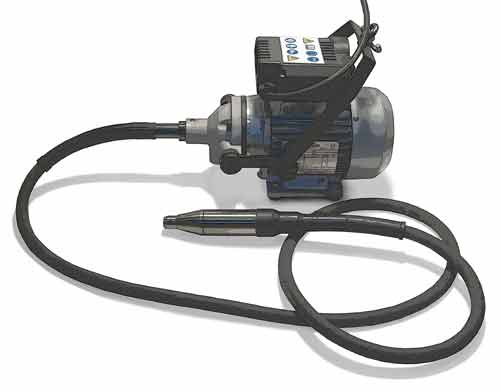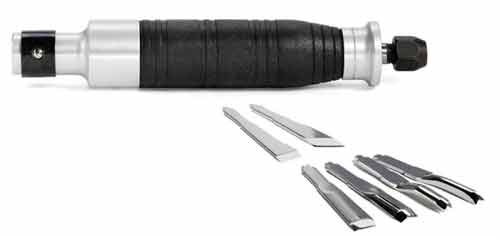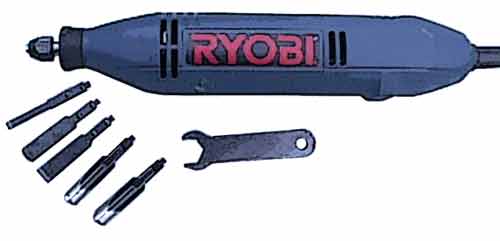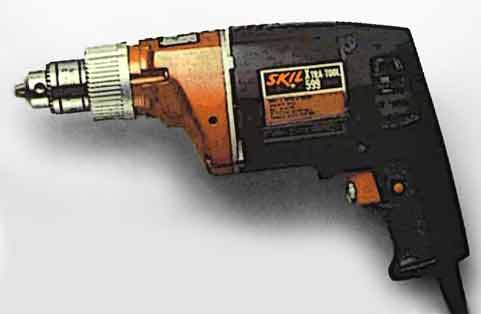 | ||||
home / about the artist / stoneboat series / lipwork series / metaphorical presences / landscapes / multi-element installation pieces / recent works
technical processes / thumbnail galleries / Cortona foundry / Finland stone carving / recommended reading / all in the family / links page
www.dondougan.com
DON DOUGAN
ELECTRO-MECHANICAL HAMMERS
TRADITIONAL PROCESSES
The Gelma Company in Italy introduced their electro-mechanical carving hammer The Woodpecker to the stonecarving and woodcarving industry in 2000.
 | ||||
The handpiece is about the same weight as a medium-weight pneumatic hammer - very similar to my 3.2 lb.Dallet long stroke (view here) - while the motor and flexible shaft provide about the same degree of striking power as a pneumatic hammer.
Electro-mechanical hammers have been around for many years in various design permutations primarily aimed to serve woodworking and hobbyist carvers working on a small scale. The cutting-blades for most of these carving hammers are made from thin sheet-metal, pressed into shapes that mimic the cutting ends of traditional woodcarving gouges, chisels, and V-tools. The rear-end of these flat-metal blades fit into a specially-shaped collet which is either attached directly to the tool motor or to a handpiece fitted to a flexible shaft. Small detail work in alabaster and soapstone can be carved with the blades made for wood, but these types of electrical carving hammers are too lightweight for carving harder stones, and there are not any blades/chisels available from the manufacturers specifically designed for carving stone.
 | ||||
Foredom handpiece #50
Handpiece fits on the flexible shaft
attached to the motor. The handpiece converts the rotary motion of the shaft
to a reciprocal hammering action.
 | ||||
Ryobi Detail Carver DC500
Blades interchange with Foredom and a number of other brands of reciprocating carving tools.
 | ||||
Skil X-Tra Tool (circa 1976-1980)
Rotary drill, hammer drill, non-rotary hammering action.
Available in 1/2" or 3/8" (shown) chuck versions.
Some brands of hammer drills are made to accept standard key-tightening chucks and also allow a reciprocating hammer action without any rotation. This allows cylindrical-shank carving tools to be used in the hammer for carving. The biggest disadvantage to carving with this set-up is the weight and awkwardness to the operator while holding the large motor-housing while carving.
 | ||||
The handpiece design by Gelma is made to fit the standard 1/2-inch (12.5mm) diameter shanks of common pneumatic carving chisels, though they also provide an adaptor to hold small detail-carving chisels with the nominal shank diameter of 5/16 (7.4mm), and can supply adaptors of other sizes to order.
Woodpecker flexible shaft carving machine
230V single phase motor
handpiece to fit on the Woodpecker flexible shaft
One of the main features of this hammer is the automatically-controlled percussive strength which varies according to the pressure imposed on the hammer by the user. This allows the user to work in a range from general rough carving to delicate finishing work.
Gelma suggests that the maximum width of the chisel cutting-edge be limited to 16mm (5/8") to prevent undue stress on the flexible shaft and overheating of the handpiece, but I have found that intermittent surfacing work with wider bolsters and droves works fine and does not seem to make the tool labor excessively or overheat.
Gelma also now makes a smaller version of the tool as well, called the 'Minipecker' with a total weight of slightly less than 15 lbs. (6.8kg). The handpiece for this tool is also both smaller and lighter weight, but it accepts only the 7.5mm shank carving tools.
The Woodpecker motor runs very quietly when not under load, and when carving stone the noise produced by the striking of the handpiece and chisel is comparable to that of a pneumatic hammer with the air volume adjusted down. The overall weight of the Woodpecker is just under 21 lbs. (9.5kg) so it is easily portable, though in use the Woodpecker motor must hang from an overhead support. To make it as flexible as possible I have fitted an overhead hook from which I can easily hang the tool above each of the carving areas where I work - including one above an outdoor carving-table for when the weather is nice.
The tool is roughly comparable in price to a medium-to-large size pneumatic carving hammer plus a 60 gallon single-stage compressor with all the required air fittings and hoses. For use with standard 110 voltage in the U.S.A. a step-up voltage transformer will be required as well, adding perhaps another 7% to the cost.
The link for the only English-language distributor of the Woodpecker tool:
NOTE: I am sorry to say that I recently heard that Gelma may have prevented G.Gibson from distributing any more Woodpeckers to clients in the USA -- a shame as I like my tool a lot . . . .




